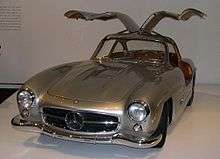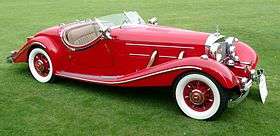Friedrich Geiger
| Friedrich Geiger | |
|---|---|
 Friedrich Geiger. | |
| Born |
24 November 1907 Süßen, Germany |
| Died |
13 June 1996 Bad Überkingen, Germany |
| Known for | Automobile design |
Friedrich Geiger (24 November 1907 – 13 June 1996) was a German automobile designer whose most notable cars, the pre-World War II Mercedes-Benz 540K and post-war Mercedes-Benz 300SL, are among the most highly regarded in automotive history.
Biography
Born in Süßen in the Swabian region of southern Germany, Geiger originally trained as a cartwright, before studying as a design engineer at University prior to joining Daimler-Benz in April 1933. He began in the special vehicles manufacturing department, where, in the 1930s, he was responsible for the 500K and 540K sports cars.
He left Daimler-Benz in April 1948, but returned to the company barely two years later, this time as a test engineer in the styling department. He became head of styling within a few years, after designing the iconic 300SL gullwing coupé, named one of the ten greatest Mercedes ever built and one of the 25 greatest cars of the 20th century.[1][2]
He continued to work at Daimler-Benz until his retirement in December 1973, by which time he had helped create the W111/W112 (1959) and W110 (1961) "Fintails", the W113 "Pagoda" (1963) and R107 (1971) SL coupé/convertibles, the W108/109 (1965) and W116 (1972) series of the S-Class, and the ultra-luxurious and long-lived Mercedes-Benz 600 limousine (1963).
He was succeeded by Bruno Sacco, one of his staff at the styling department, who would go on to be shortlisted as one of the car designers of the century. He died in Bad Überkingen in 1996, aged 88. On the centenary of his birth in March 2007 Sacco paid tribute to his mentor, acknowledging the outstanding reputation he enjoys among younger automotive designers thanks to the timelessness of his designs.
Gallery
-

A 1955 Mercedes-Benz 300SL with its gullwing doors ajar.
Notes
- ↑ Biggs, Henry. "Top 10: greatest-ever Mercedes". MSN Cars UK.
- ↑ Dornin, Tim (March 15, 1999). "Car of the century voting narrows". AAP General News.
References
- Engelen, Günter (March 2007). "100th anniversary of Friedrich Geiger". Mercedes-Benz Classic.
- Mattar, George (February 2008). "The Man Behind Great Tri-Stars". Hemmings Sports & Exotic Car. Retrieved 7 May 2014.


